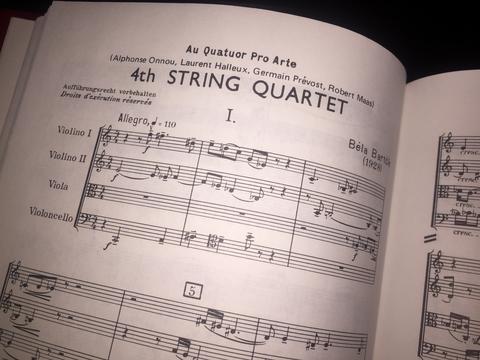Bela Bartók’s string quartets are widely viewed to be the most significant contribution to the genre since Beethoven’s, 100 years earlier. As we look forward to the final concert in the Fry Street Quartet’s exploration of these incredible pieces, we thought we’d share a few interesting tidbits about. Did we miss something important? Let us know in the comments!
1. The string quartets encompass Bartók’s entire career as a composer.
His first quartet was completed in 1909, when he was 27. His sixth quartet premiered just four years before his death.
2. Many subsequent composers have looked to Bartók’s quartets for inspiration.
Britten’s Cello Sonata makes reference to these works, as do the string quartets of Carter, Ligeti, and György Kurtág. (We’ll hear from Kurtág on April 15, when his Signs, Games, and Messages are interspersed with Bach’s G major Cello Suite.)
3. Bartók’s quartets were inspired by the folk music of his native Hungary.
Bartók wasn’t just a composer— he was one of the first and greatest ethnomusicologists, and he frequently journeyed throughout the countryside of Eastern Europe, transcribing the folk music of the villages he encountered. These melodies— so different from the rhythms and scales of “proper” classical music— piqued his imagination and infused the music he composed.
4. Bartók uses a lot of special effects in his quartets.
String music before Bartók mostly used two different techniques: bowing and plucking (called “pizzicato”). While he wasn’t the first to use other techniques, they permeate Bartók’s quartets in a way not before seen in music. The musicians beat the string with the wood of the bow (col legno), slide along the strings in glissandi, play over the fingerboard (sul tasto) or the bridge (sul ponticello), strum like a guitar, and— most uniquely— pluck the string so strongly that it rebounds against the fingerboard with an audible “snap”. This technique has become so identified with these quartets that it’s known as a “Bartók pizzicato”. You’ll hear quite a few examples of this technique in the fourth movement of Quartet No. 4.
5. Playing all six of Bartók’s quartets is a major achievement for any string quartet.
Just as orchestras embark on cycles of all nine of Beethoven’s symphonies, it’s a major milestone for string quartets to perform all six of Bartók’s quartets.
Over the last two years, we’ve had the privilege of joining the Fry Street Quartet as they’ve taken this journey. Join us on Sunday as they perform the final concert in this series!

